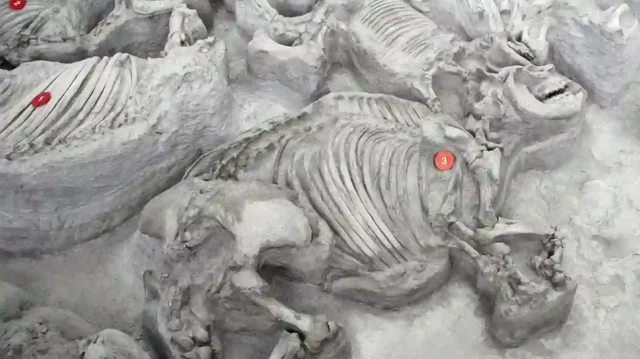
Millions of years ago, the plains of Nebraska were home to an unusual sight—herds of barrel-bodied rhinos gathering in large numbers around watering holes. Unlike their modern, solitary relatives, these prehistoric creatures may have lived in tight-knit communities, much like today’s hippos.
A recent study published in Scientific Reports sheds new light on the social behavior of Teleoceras, an extinct rhino species with a stout, hippopotamus-like build. By analyzing fossilized teeth from the Ashfall Fossil Beds in Nebraska, researchers uncovered surprising details about their lifestyle, diet, and the catastrophic event that wiped them out.
A Volcanic Disaster Preserved in Time
Around 12 million years ago, during the Miocene Epoch, a massive eruption from the Yellowstone supervolcano blanketed much of North America in ash. Nebraska’s Ashfall Fossil Beds—once a thriving watering hole—became a death trap for local wildlife. A thick layer of volcanic ash suffocated animals, preserving their skeletons in remarkable detail.
Clark Ward, a paleontologist at the University of Minnesota, explains that the ashfall would have been similar to an intense dust storm, choking the air and poisoning vegetation. Over time, hundreds of animals perished near the water source, including dozens of Teleoceras rhinos.
Were These Rhinos Social or Solitary?
Modern rhinos are largely solitary, but fossil evidence suggests Teleoceras may have behaved differently. To determine whether these ancient rhinos lived in herds or wandered alone, researchers analyzed isotopes in their teeth.
By studying carbon, oxygen, and strontium ratios, scientists could reconstruct the rhinos’ diet, migration patterns, and even the climate they lived in. Danielle Fraser, an evolutionary biologist at the Canadian Museum of Nature, explains that strontium ratios are particularly useful for tracking an animal’s movement—different regions have distinct chemical signatures.
The results were surprising. The rhinos’ teeth showed little variation in strontium levels, meaning they likely stayed in the same area rather than migrating. Additionally, carbon isotopes revealed a consistent diet of local grasses, suggesting they had no need to travel far for food.
A Herd Lifestyle, Like Hippos?
The sheer number of Teleoceras fossils at Ashfall hints that these rhinos lived in large groups. Unlike modern rhinos, which are territorial and often solitary, Teleoceras may have gathered in herds for protection, social interaction, or access to prime grazing spots.
Ward initially expected to find evidence of young males traveling to find mates, as seen in many modern mammals. However, the chemical data suggested otherwise—most rhinos stayed close to home. This raises questions about how they avoided inbreeding. One possibility is that neighboring herds occasionally mixed, ensuring genetic diversity.
A Thriving Ecosystem Before the Ashfall
The study also offers clues about Nebraska’s ancient environment. If Teleoceras didn’t need to migrate, the region must have had abundant food and water year-round. Ward notes that the Miocene climate was warmer and wetter, possibly supporting lush vegetation that could sustain large herds of rhinos, horses, and camels.
Another intriguing possibility is that the herbivores themselves helped maintain the ecosystem. By grazing and fertilizing the land, they may have promoted plant growth, creating a cycle that kept the landscape fertile.
A Glimpse into Prehistoric Life
The Ashfall Fossil Beds provide a rare snapshot of life—and death—in the distant past. The Teleoceras rhinos, with their stocky bodies and social tendencies, offer a fascinating contrast to their modern relatives. Their story also highlights how sudden disasters, like volcanic eruptions, can reshape entire ecosystems in an instant.
Future research may explore how other species at Ashfall interacted, providing an even clearer picture of this ancient world. For now, the discovery of these herd-dwelling rhinos adds a new chapter to our understanding of prehistoric life.








